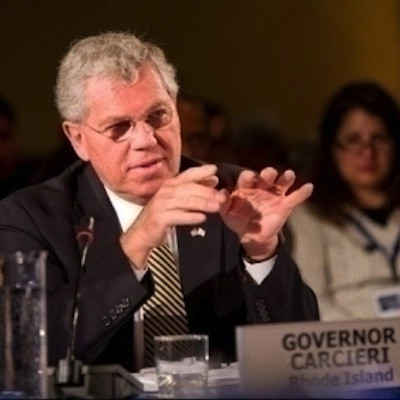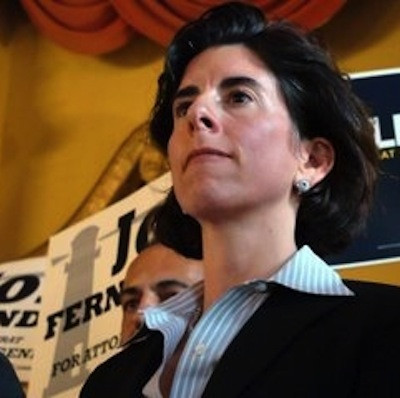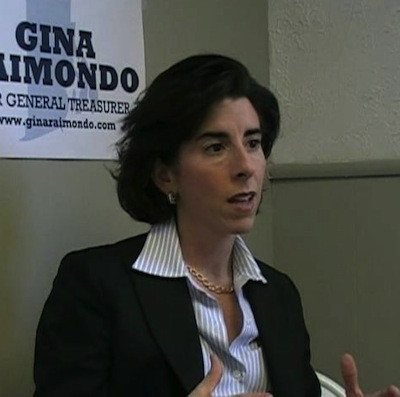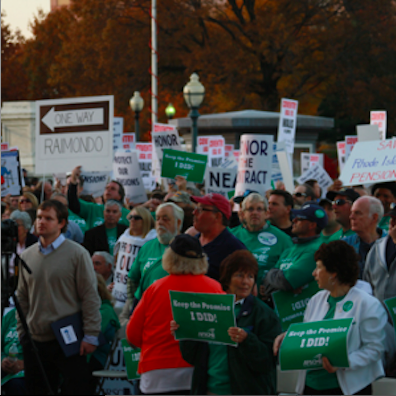Siedle: Red Flags Pepper RI Pension’s Investment In Governor Raimondo’s Venture Fund
Sunday, February 05, 2017
There are more red flags surrounding the Rhode Island state pension’s investment in a venture fund managed by, and sold to, the pension by current Governor Gina Raimondo than at the Beijing Olympics opening ceremony.
The pension fund made the $5 million investment in the Point Judith Venture Fund II ten years ago while Raimondo was a Point Judith general partner—four years before she successfully ran for state Treasurer and became the chief fiduciary of the state retirement system.
For years Raimondo has claimed to be a successful venture capitalist and she has indeed done well for herself, having reportedly made approximately $1 million off the state pension thanks to the high fees—among the highest paid by the fund— the pension paid her.
GET THE LATEST BREAKING NEWS HERE -- SIGN UP FOR GOLOCAL FREE DAILY EBLASTFurther, unlike the state which paid millions for its shares in the fund, the Treasurer was granted ownership interests for free.
The state pension would have been well-advised to steer clear of this politically-charged investment and should have heeded warnings.
The state's investment posted a negative 2.9 percent return through December 31, 2016, according to the most recent performance figures from the Treasury.
To make matters worse, in late 2016 Point Judith notified the Treasury that it intended to exercise the first of two, one-year options on the state's investment.
Will a final accounting of the Point Judith investment will be delayed until after the next election?
“Clearly they haven't been our best performer," current Treasurer Seth Magaziner said in an interview in November.
Magaziner further conceded such small investments don't make much sense for the pension system, as the potential returns don't match the demands on staff to monitor them.
"I would not do an investment of that size today," Magaziner reportedly said.
What young Magaziner isn’t saying is how much would the Raimondo investment be worth if sold today—assuming it could be sold.
Raimondo and her successor Magaziner have both obscured Point Judith performance for years.
Here’s what my firm had to say three years ago about the strikingly divergent performance claims regarding the pension’s investment in the Raimondo-managed fund:
“In a Power Point presentation provided to us by Treasurer Raimondo, the investment performance of the Point Judith I and II funds, as well as the performance of investments made by the professionals at the firm prior to joining Point Judith is presented. However, all such performance information has been redacted.
Thus, we do not know either the performance information provided by Point Judith to the state pension in connection with the Point Judith II investment, or whether the information provided to the pension was, in fact, accurate. If inaccurate, the Treasurer’s office may be withholding information from the public regarding potential violations of law.
Nevertheless, Treasurer Raimondo has made numerous public statements regarding the performance of the Point Judith II fund, as well as released summary performance figures which are strikingly divergent.
22 Percent Return: In an April 5, 2013 interview, Treasurer Raimondo stated that the Point Judith II investment was reviewed for ERSRI by the pension’s private equity consultant at that time. Further, the performance of Point Judith at that time was, according to the Treasurer, top quartile in 2007.
“It’s a strong performer. They’ve produced strong returns. It’s still a little bit early. Those kinds of firms have a 10-year investment life cycle, so they’re maybe halfway through the cycle,” she said.
Treasurer Raimondo went on to state, “As I suspected they have solid performance, a realized return of 22% – so a 22% realized return, but again, they’re halfway through the fund. Early returns are strong, but like any of these private equity holdings, you have to wait until the fund is done to see how they’ve performed.”
12 Percent Return: On April 9, 2013 it was reported that the Treasurer’s spokeswoman provided a correction saying the Point Judith II fund “has a 12% return; 22% is the amount that has been cashed in.”
Obviously, there is a massive difference between a 22 and 12 percent return.
10.9 Percent Return: In a May 2, 2013 interview, the Treasurer’s office stated that the Point Judith II had an annualized rate of return of 10.9 percent as of June 2012.
6.2 Percent Return: On October 10, 2013, the Treasurer’s office stated Point Judith II had an annualized internal rate of return of 6.2 percent.
4 Percent Return: In response to our request for complete information regarding the Point Judith II fund, we received from Raimondo severely limited performance information which simply stated quarterly capital account values and internal rates of return.
Without a schedule of contributions and distributions and audited financials indicating the fund’s portfolio holdings and their values, it is impossible to verify any of Treasurer Raimondo’s claims regarding the fund’s performance, or to independently calculate such performance with any certainty. However, based simply upon the incomplete data provided, it appears that the annualized returns are significantly less than the 22 percent, 12 percent, 10.9 percent or 6.2 percent represented by the Treasurer.
In fact, our best estimate of approximately 4 percent will compound to less than what has been delivered by the traditional equity markets due to the extremely high volatility. Furthermore, market investments would have involved significantly lower fees and risk than this venture capital investment.
-16.7 Percent Return: On July 12, 2013, summary data provided by the Treasurer to GOLOCAL PROV revealed that “in the four-year period the performance of the fund has been weak.”The cumulative rate of return of the fund was calculated to be -16.7 percent by an expert commentator.
Conclusion
In conclusion, as a result of Treasurer Raimondo’s refusal to disclose all of the material information regarding Point Judith Capital and the Point Judith II fund she formerly managed and marketed to the state pension, choosing instead to disclose limited unverified information which is wildly inconsistent, it is impossible for the general public, participants and taxpayers to assess her and the firm’s investment capabilities, as well as whether the state pension should have ever invested, or should remain invested, in the Point Judith II fund.
In our opinion, in order to prevent any possible confusion or misleading of investors, it is appropriate to refer this matter to the SEC for investigation.”
In closing, recall Raimondo’s words:
“These kinds of firms have a 10-year investment life cycle.”
“You have to wait until the fund is done to see how they’ve performed.”
Apparently, with regard to the investment performance of this politically-charged investment, Rhode Islanders are going to have to wait a year or two longer.
Related Slideshow: Timeline - Rhode Island Pension Reform
GoLocalProv breaks down the sequence of events that have played out during Rhode Island's State Employee Pension Fund reform.
Related Articles
- NEW: Forbes’ Siedle to Conduct New Investigation into RI Pension Fund
- Ted Siedle and Matt Taibbi: 13 Who Made a Difference in RI in 2013
- NEW: Forbes’ Siedle Launches Crowdfunding Site to Investigate Pensions
- NEW: RI Pension Investigation Kickstarter Campaign by Forbes’ Siedle Goes Live
- Siedle’s Pension Investigation Crowdfunding Project Breaks 52%
- In Case You Missed It: Siedle Report on RI Pension Investments
- State Pension System to be Investigated by Siedle
- Ted Siedle: Hedge Fund Industry Loves RI Pension—For Good Reason
- MINDSETTER™ Ted Siedle: News from the State Pension is All Good
- NEW: Siedle Blasts Raimondo for Withholding Hedge Fund Info
- Forbes’ Siedle Hits Goal with KickStarter to Audit RI Pension System
- NEW: Forbes’ Siedle Releases Latest Investigation into RI Pension System
- Magaziner Should Return $10K to Retired Teachers for Withholding Key Documents, Says Siedle
- Magaziner Demanding $10K for Public Records Request from Forbes’ Siedle
- RI Pension Investigator Siedle in NYT for $1M Indiana Settlement, Coming to RI in October
- Siedle: FBI & SEC Should Investigate Raimondo & Magaziner’s Billion-Plus Losing Hedge Fund Gamble
- Forbes Columnist Siedle: “Rhode Islanders Were Lied to by Raimondo”
- Forbes’ Siedle Blasts Rhode Island for Not Hiring Him in Light of SEC Charges
- Siedle Calls Cianci “Rhode Island’s Least Dangerous Politician”
- Riley: AFSCME, Ted Siedle and Marcia Reback Hurt Rhode Island Retirees
- Forbes Columnist Siedle Responds to MINDSETTER™ Riley’s Charges
- RI Retired Teachers Hire Forbes’ Siedle
- Forbes’ Siedle Eyes New Rhode Island Pension Investigation
- Siedle: WikiLeak Exposes Seth Magaziner’s Dependence on Daddy








































